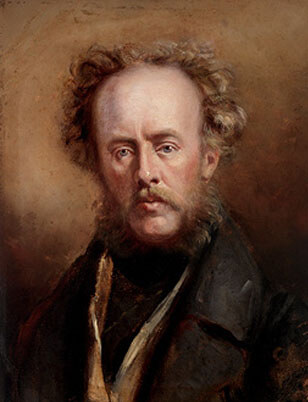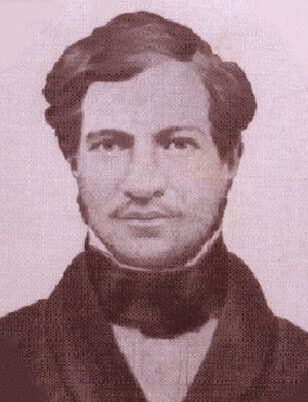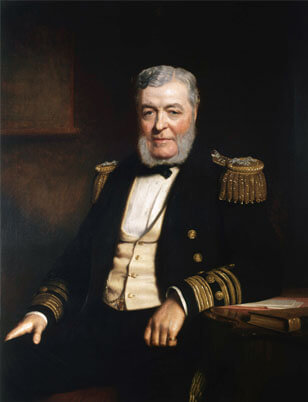Meet the Crew
When HMS Beagle set sail on 27 December 1831, Captain Fitzroy stated that there were 74 people on board. On this page, you can discover the stories behind some of the passengers aboard the ship with whom Darwin spent five years away from home.
When the Beagle left England in 1831 there were 74 men on board. On her return almost 5 years later there were 12 less. Some crew members left and unfortunately 5 died during the voyage from illness or accident. During the time in Galapagos there were approximately 65 crew on board. Occasionally numbers on board would increase as Captain Fitzroy was committed to transporting stranded or shipwrecked sailors. Even animals were known to wander the decks, including the Galapagos giant tortoises!
More unusual passengers on board the Beagle included Fuegia Basket and Jemmy Button (or Orundellico) who were both taken from their homes in Tierra del Fuego all the way back to England. Here they were taught English, Christianity and agriculture, amongst other things. Both eventually returned to their homes and settled back to their previous lives.


Vice-Admiral Robert Fitzroy R.N. (1805-1865)
Fitzroy was born in Ampton, Suffolk into an aristocratic family. At the age of only 12, he entered the Royal Naval College in Portsmouth. At the age of 14, he travelled with HMS Owen Glendower to South America and in 1824 he was promoted to lieutenant. After the captain of HMS Beagle at the time, named Pringle Stokes, shot himself, Fitzroy was appointed as temporary captain of the Beagle. In his long career as a man of the sea, he went on to publish his theories on meteorology and invented several types of barometer to allow sailors to check a weather forecast before leaving port.
Click here for Robert Fitzroy's ship profile
Job title: Ship’s Captain
Job description:
- Ensure the safe operation of the Beagle in sometimes treacherous waters
- Navigate the Beagle using charts and maps
- Inspect and maintain all on-board equipment
- Investigate any damage to the Beagle or injuries of any crew member
- Interview and hire crew members
- Responsible for all purchases, including food, supplies and equipment
- Explain and monitor the crew member’s jobs on board the vessel
Character:
- Fair and law abiding
- Calm in emergencies, including being shot at from other ships
- Be prepared for long periods of time away from home
- Excellent man-management skills for drunken, violent and insolent crew-members
- Highly organised and a good eye for detail

John Wickham (1798-1864)
John Wickham was a Scottish naval officer, explorer and hydrographer. He was the first officer during the second voyage of HMS Beagle. He later became Captain of the Beagle and conducted many maritime expeditions. He also became Police Magistrate and later Government Resident of the Moreton Bay District in New South Wales, Australia.
Click here for John Wickham's ship profile
Job title: First Officer (or Chief Mate)
Job description:
- Responsible to the Captain for the safety and security of the Beagle
- Train the crew in safety, firefighting and other disasters that may occur
- Act as ‘Sea Watch’ to safely navigate the ship
- Understand the construction of the Beagle to help keep it seaworthy
Character:
- Not argumentative. You are answerable to the Captain, whether you agree with him or not!
- Patience to train and organise a big crew of unruly sailors
- Excellent observation skills. As ‘Sea Watch’ you must be able to identify any dangers and also passing whales and other sea creatures to report to Mr Darwin

Conrad Martens (1801-1878)
Conrad Martens was an English landscape painter who accompanied HMS Beagle to Patagonia but took another vessel from Valparaiso to Sydney where he became a prolific landscape painter in New South Wales, Australia. He also painted a number of watercolours of Tierra del Fuego and the Pacific, paid for by Fitzroy.
Click here for Conrad Martens' ship profile
Job title: Ship’s Artist
Job description:
- Excellent landscape painter
- Good eye for detail and accuracy
- Experience of working under pressure with limited time
- Good sense of balance. Have you tried painting on board a ship in rough seas?
- Able to take orders from the Captain and First Officer for requirements
Character:
- Imaginative and creative.
- Non-judgemental. You may see things that surprise and shock you.
- Sensitive to other crew members. Remember you may have to paint them in your pictures – Now, which is my best side?

Robert McCormick (1800-1890)
Robert McCormick was a British Royal Navy Ship’s Surgeon, an explorer and a naturalist. He joined the Beagle in hopes of collecting specimens and becoming a famous naturalist, however found himself unable to go onshore to collect specimens most of the time. He was described by Charles Darwin as ‘my friend the doctor is an ass, but we jog on very amicably’. He later joined an Antarctic expedition from 1839 to 1842 and the south polar skua was named after him.
Click here for Robert McCormick's ship profile
Job title: Ship’s Surgeon
Job description:
- Responsible for the health of all crew on board the Beagle
- Diagnosis and treatment of disease and illness, including fever such as Malaria
- Visiting patients regularly and keep accurate records of car
- Keeping medical areas clean and free from blood and body bits
Character:
- Calm and caring personality
- Quick-minded and able to make a fast diagnosis
- Have a strong stomach during difficult treatments such as amputation
- Ability to treat patients during severe seas whilst being thrown around the cabin
- A steady surgical hand

Syms Covington (1816-1861)
Syms Covington was a fiddler and boy to the poop-cabin on HMS Beagle and later during the voyage became Darwin’s servant boy and assistant in taxidermy and collecting specimens. He continued working for Darwin after their return to England and proved very useful as he had labelled where in the Galapagos Islands he had caught his finches. This allowed a relationship to be established between the individual islands and the species found there.
Click here for Syms Covington's ship profile
Job title: Fiddler and boy to the poop cabin
Job description:
- Servant boy and assistant to Mr Darwin
- Assist in collection and preservation of specimens
- Shoot and collect vertebrates for Mr Darwin (he prefers studying to shooting!)
- Join Mr Darwin on shore excursions and set up a camp for the night away from nosey iguanas and erupting volcanoes
- Secretarial duties
- Assisting Mr Darwin when he has terrible bouts of sea-sickness
Character:
- Quick to learn.
- You will need to be able to pickle an octopus and squeeze a giant tortoise into a crate without a fuss
- Good survival skills in the great outdoors where water supply is non-existent. Mr Darwin is your responsibility on land based trips
- Caring personality. You will need to assist Mr Darwin during his terrible bouts of sea-sickness
- Ability to work all hours – ideas of genius are always around the corner with Mr Darwin

George Phillips (1807-?)
George Phillips was 24 years old when he set sail aboard the HMS Beagle. He was a seaman before he became the ship’s cook, a big responsibility with so many hungry sailors aboard!
Click here for George Philips' ship profile
Job title: Ship’s Cook
Job description:
- Preparation of food for all crew members
- Good timing skills to meet the meal times on board
- Maintain cleanliness of galley and all equipment, including clearing of rodents
- Make sure all food is stored properly, including the roaming tortoises in the ship’s hold
- Remove excessive amounts of weevils (beetles) from food sources
- Imaginative cooking skills. You may need to make tortoise soup or tropical bird stew
Character:
- Highly organised and efficient. You have 74 strong, hearty men to feed
- A sense of humour. You may need to see the funny side of balancing boiling pots and pans during stormy seas
- A good imagination. How many meals can you make from a giant tortoise?
Admiral John Lort Stokes (1811-1885)
Admiral John Lort Stokes was a naval officer who travelled on HMS Beagle for almost 18 years. On the second voyage of the Beagle, he was the assistant surveyor and he shared a cabin with Charles Darwin. He is known as the man to have discovered and named Victoria River and Port Darwin and his maps of north Australia were still used all the way up to the Second World War. He also wrote a book called “Discoveries in Australia”, with an account of the coasts and rivers explored and surveyed during the voyage of the Beagle between 1837-1843.

